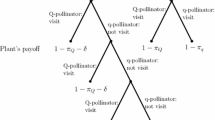Abstract
Plant–pollinator–robber systems are considered, where the plants and pollinators are mutualists, the plants and nectar robbers are in a parasitic relation, and the pollinators and nectar robbers consume a common limiting resource without interfering competition. My aim is to show a mechanism by which pollination–mutualism could persist when there exist nectar robbers. Through the dynamics of a plant–pollinator–robber model, it is shown that (i) when the plants alone (i.e., without pollination–mutualism) cannot provide sufficient resources for the robbers’ survival but pollination–mutualism can persist in the plant–pollinator system, the pollination–mutualism may lead to invasion of the robbers, while the pollinators will not be driven into extinction by the robbers’ invasion. (ii) When the plants alone cannot support the robbers’ survival but persistence of pollination–mutualism in the plant–pollinator system is density-dependent, the pollinators and robbers could coexist if the robbers’ efficiency in translating the plant–robber interactions into fitness is intermediate and the initial densities of the three species are in an appropriate region. (iii) When the plants alone can support the robbers’ survival, the pollinators will not be driven into extinction by the robbers if their efficiency in translating the plant–pollinator interactions into fitness is relatively larger than that of the robbers. The analysis leads to an explanation for the persistence of pollination–mutualism in the presence of nectar robbers in real situations.
Similar content being viewed by others
References
Beddington JR (1975) Mutual interference between parasites or predators and its effect on searching efficiency. J Anim Ecol 44: 331–340
Butler GJ, Freedman HI, Waltman P (1986) Uniformly persistent systems. Proc Am Math Soc 96: 425–430
Butler GJ, Waltman P (1986) Persistence in dynamical systems. J Differ Equ 63: 255–263
Cosner C (1996) Variability, vagueness and comparison methods for ecological models. Bull Math Biol 58: 207–246
Darwin C (1859) The origin of species. Penguin Books, London
Darwin C (1876) The effects of cross and self-fertilisation on the vegetable kingdom. Appelton, New York
DeAngelis DL, Goldstein RA, O’Neill RV (1975) A model for trophic interaction. Ecology 56: 881–892
Fishman MA, Hadany L (2010) Plant–pollinator population dynamics. Theor Popul Biol 78: 270–277
Freedman HI, Waltman P (1984) Persistence in a model of three interscting predator–prey populations. Math Biosci 68: 213–231
Freedman HI, Moson P (1990) Persistence definitions and their connections. Proc Am Math Soc 109: 1025–1033
Freedman HI, Ruan S, Tang M (1994) Uniform persistence and flows near a closed positively invariant set. J Dyn Differ Equ 6: 583–600
Hofbauer J, Sigmund K (1998) Evolutionary games and population dynamics. Cambridge University Press, Cambridge
Hsu S-B, Hwang T-W, Kuang Y (2001) Rich dynamics of a ratio-dependent one-prey two-predator model. J Math Biol 43: 377–396
Inouye DW (1983) The ecology of nectar robbing. In: Beattey B, Elias T (eds) The biology of nectaries. Columbia University Press, New York, pp 153–173
Irwin RE, Bronstein JL, Manson JS, Richardson L (2010) Nectar robbing: ecological and evolutionary perspectives. Annu Rev Ecol Evol Syst 41: 271–292
Jang SR-J (2002) Dynamics of herbivore–plant–pollinator models. J Math Biol 44: 129–149
Kuang Y, Freedman HI (1988) Uniqueness of limit cycles in Gause-type predator–prey systems. Math Biosci 88: 67–84
Liou L-P, Cheng K-S (1988) Global stability of a predator–prey system. J Math Biol 26: 65–71
McCall AC, Irwin RE (2006) Florivory: the intersection of pollination and herbivory. Ecol Lett 9: 1351–1365
Oña L, Lachmann M (2011) Ant aggression and evolutionary stability in plant–ant and plant–pollinator mutualistic interactions. J Evol Biol 24: 617–629
Pianka ER (1974) Evolutionary ecology. Harper and Row, New York, pp, pp 133–146
Roubik DW (1982) The ecological impact of nectar-robbing bees and pollinating hummingbirds on a tropical shrub. Ecology 63: 354–360
Sprengel CK (1793) The secret of nature in the form and fertilization of flowers discovered. Friedrich Vieweg Altere, Berlin
Thieme HR (1992) Convergence results and a Poincaré–Bendixson trichotomy for asymptotically autonomous differential equations. J Math Biol 30: 755–763
Thieme HR (1993) Persistence under relaxed point-dissipativity. SIAM J Math Anal 24: 407–435
Waltman P (1991) A brief survey of persistence in dynamical systems. In: Lecture notes in mathematics, vol. 1475/1991. Appelton, New York, pp 31–40
Wang Y, Wu H, Ruan S (2011) Periodic Orbits near heteroclinic cycles in a cyclic replicator system. J Math Biol. doi:10.1007/s00285-011-0435-3
Wang Y, Wu H, Sun S (2012) Persistence of pollination mutualisms in plant–pollinator–robber systems. Theor Popul Biol 81: 243–250
Werner EE, Peacor SD (2003) A review of trait-mediated indirect interactions in ecological communities. Ecology 84: 1083–1100
Wootton JT (1994) The nature and consequences of indirect effects in ecological communities. Annu Rev Ecol Syst 25: 443–466
Yang F, Ruan S (1996) A generalization of the Butler–McGehee lemma and its applications in persistence theory. Differ Integral Equ 9: 1321–1330
Zhang Z, Ding T, Huang W, Dong Z (1992) Qualitative theory of differential equations. In: Translations of mathematical monographs, vol 101. AMS, Province, RI
Author information
Authors and Affiliations
Corresponding author
Rights and permissions
About this article
Cite this article
Wang, Y. Dynamics of plant–pollinator–robber systems. J. Math. Biol. 66, 1155–1177 (2013). https://doi.org/10.1007/s00285-012-0527-8
Received:
Revised:
Published:
Issue Date:
DOI: https://doi.org/10.1007/s00285-012-0527-8




